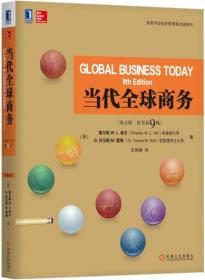
当代全球商务(英文版·原书第9版)
¥ 21.25 2.4折 ¥ 89 九品
仅1件
作者查尔斯W.L.希尔(Charles W.L.Hill) 著;王炜瀚 译
出版社机械工业出版社
出版时间2017-08
版次1
装帧平装
上书时间2024-12-13
- 在售商品 暂无
- 平均发货时间 9小时
- 好评率 暂无
- 最新上架
商品详情
- 品相描述:九品
图书标准信息
- 作者 查尔斯W.L.希尔(Charles W.L.Hill) 著;王炜瀚 译
- 出版社 机械工业出版社
- 出版时间 2017-08
- 版次 1
- ISBN 9787111572350
- 定价 89.00元
- 装帧 平装
- 开本 16开
- 纸张 胶版纸
- 页数 487页
- 丛书 高等学校经济管理英文版教材(双语注释版
- 【内容简介】
-
本书是一本广受国内外读者欢迎的国际商务教材。全书详细介绍了当代国际商务的各个方面,特别关注国际商务的战略与结构以及企业各种职能的国际商业含义,既具有综合性又具有时效性。作者将许多主要的经济、贸易理论融入案例之中,用来解释发生在我们周围的具体事例,使理论的意义更加明确,使读者能够深刻地领会国际商务理论的深层含义。
- 【作者简介】
-
华盛顿大学商学院国际商务专业休斯 M.布莱克研究室教授。希尔教授于1983年在英国曼彻斯特理工大学(UMIST)获得工业管理经济学博士学位。除了在华盛顿大学任职,他还兼职英国曼彻斯特理工大学、美国德克萨斯A&M大学及密歇根州立大学。希尔教授在华盛顿大学讲授MBA课程和实施MBA课程,并在两个课程上都获得了教学奖。
- 【目录】
-
目 录
出版说明
作者简介
前言
术语表
致谢
第一部分 介绍和概述
第1章 全球化3
学习目标/开篇案例
概述4
1.1 什么是全球化6
1.2 全球机构的出现8
1.3 全球化的推动力11
1.4 全球经济中不断变化的统计数据15
1.5 全球化的争议22
1.6 全球市场中的管理29
本章小结/思考与讨论题/章末案例/注释
第二部分 国家间的差异
第2章 政治、经济、法律体制的国别差异37
学习目标/开篇案例
概述38
2.1 政治体制39
2.2 经济体制43
2.3 法律体制45
聚焦管理启示51
本章小结/思考与讨论题/章末案例/注释
第3章 经济发展的国别差异57
学习目标/开篇案例
概述58
3.1 经济发展的差异59
3.2 政治经济与经济进步61
3.3 转型中的国家64
3.4 经济转型的性质67
3.5 政治经济变革的启示70
聚焦管理启示70
本章小结/思考与讨论题/章末案例/注释
第4章 文化差异79
学习目标/开篇案例
概述81
4.1 文化是什么82
4.2 社会结构85
4.3 宗教与伦理体系90
4.4 语言96
4.5 教育98
4.6 文化与商业99
4.7 文化的变化102
聚焦管理启示104
本章小结/思考与讨论题/章末案例/注释
第5章 伦理、企业社会责任及可持续发展113
学习目标/开篇案例
概述114
5.1 国际商务中的伦理问题115
5.2 伦理困境120
5.3 不合乎伦理行为的根源121
5.4 伦理的哲学理论123
聚焦管理启示129
本章小结/思考与讨论题/章末案例/注释
第三部分 全球贸易与投资环境
第6章 国际贸易理论143
学习目标/开篇案例
概述144
6.1 贸易理论概述144
6.2 重商主义146
6.3 绝对优势理论148
6.4 比较优势理论150
6.5 赫克歇尔–俄林理论157
6.6 产品生命周期理论159
6.7 新贸易理论161
6.8 国家竞争优势:波特的钻石模型164
聚焦管理启示167
本章小结/思考与讨论题/章末案例/注释
附录A 国际贸易和国际收支173
第7章 政府政策与国际贸易179
学习目标/开篇案例
概述180
7.1 贸易政策工具181
7.2 支持政府干预的论点186
7.3 支持自由贸易的修正论点191
7.4 世界贸易体系的发展192
聚焦管理启示199
本章小结/思考与讨论题/章末案例/注释
第8章 外国直接投资207
学习目标/开篇案例
概述208
8.1 世界经济中的外国直接投资208
8.2 对外直接投资理论212
8.3 政治意识形态与外国直接投资217
8.4 外国直接投资的收益和成本220
8.5 政府的政策工具与外国直接投资225
聚焦管理启示228
本章小结/思考与讨论题/章末案例/注释
第9章 区域经济一体化235
学习目标/开篇案例
概述236
9.1 经济一体化的层次237
9.2 支持区域一体化的理由239
9.3 反对区域一体化的理由241
9.4 欧洲的区域经济一体化241
9.5 美洲的区域经济一体化251
9.6 其他地区的区域经济一体化257
聚焦管理启示259
本章小结/思考与讨论题/章末案例/注释
第四部分 全球货币体系
第10章 外汇市场265
学习目标/开篇案例
概述266
10.1 外汇市场的功能267
10.2 外汇市场的性质271
10.3 汇率决定的经济理论272
10.4 汇率预测280
10.5 货币可兑换性281
聚焦管理启示282
本章小结/思考与讨论题/章末案例/注释
第11章 国际货币体系291
学习目标/开篇案例
概述292
11.1 金本位制293
11.2 布雷顿森林体系295
11.3 固定汇率制度的瓦解297
11.4 浮动汇率制度298
11.5 固定汇率制与浮动汇率制301
11.6 实践中的汇率体系304
11.7 国际货币基金组织对危机的管理305
聚焦管理启示310
本章小结/思考与讨论题/章末案例/注释
第五部分 国际商务战略与进入战略
第12章 国际商务战略317
学习目标/开篇案例
概述318
12.1 战略与企业319
12.2 全球扩张、盈利能力与利润增长326
12.3 降低成本的压力和当地响应的压力332
12.4 战略选择337
12.5 战略联盟342
本章小结/思考与讨论题/章末案例/注释
第13章 进入战略351
学习目标/开篇案例
概述352
13.1 基本进入决策353
13.2 进入模式357
13.3 选择一种进入模式364
13.4 绿地新建企业或并购366
本章小结/思考与讨论题/章末案例/注释
第六部分 国际商务职能
第14章 出口、进口与对等贸易375
学习目标/开篇案例
概述376
14.1 出口的前景和困难376
14.2 提高出口业绩378
14.3 进出口融资382
14.4 出口支持387
14.5 对等贸易388
本章小结/思考与讨论题/章末案例/注释
第15章 全球生产与供应链管理397
学习目标/开篇案例
概述399
15.1 战略、生产以及供应链管理399
15.2 在哪里生产402
15.3 自制或外购决策410
15.4 全球供应链职能414
15.5 全球供应链管理417
本章小结/思考与讨论题/章末案例/注释
第16章 全球市场营销和研发427
学习目标/开篇案例
概述428
16.1 市场和品牌的全球化430
16.2 市场细分431
16.3 产品属性433
16.4 分销策略435
16.5 沟通策略438
16.6 定价策略443
16.7 配置营销组合447
16.8 国际市场调研448
16.9 新产品研发452
本章小结/思考与讨论题/章末案例/注释
第17章 全球人力资源管理463
学习目标/开篇案例
概述464
17.1 国际人力资源管理的战略作用465
17.2 人员配备政策466
17.3 培训与人才发展474
17.4 绩效评估477
17.5 薪酬478
17.6 国际劳工关系481
本章小结/思考与讨论题/章末案例/注释
contents
Foreword
About the Authors
Preface
Glossary
Acknowledgements
PART ONEIntroduction and Overview2
Chapter OneGlobalization3
Opening Case: The Globalization of Production
at Boeing3
Introduction4
What Is Globalization?6
The Globalization of Markets6
The Globalization of Production7
The Emergence of Global Institutions8
Drivers of Globalization11
Declining Trade and Investment Barriers11
The Role of Technological Change13
The Changing Demographics of the Global Economy15
The Changing World Output and World Trade Picture15
The Changing Foreign Direct Investment
Picture16
The Changing Nature of the Multinational Enterprise18
The Changing World Order20
The Global Economy of the Twenty-First Century21
The Globalization Debate22
Antiglobalization Protests22
Globalization, Jobs, and Income24
Globalization, Labor Policies, and the Environment26
Globalization and National Sovereignty27
Globalization and the World抯 Poor28
Managing in the Global Marketplace29
Summary30
Critical Thinking and Discussion Questions31
Closing Case: Who Makes the Apple iPhone?32
Endnotes33
PART TWONational Differences36
Chapter TwoNational Differences in Political, Economic, and Legal Systems37
Opening Case: Putin抯 Russia37
Introduction38
Political Systems39
Collectivism and Individualism39
Democracy and Totalitarianism42
Economic Systems43
Market Economy43
Command Economy44
Mixed Economy44
Legal Systems45
Different Legal Systems45
Differences in Contract Law46
Property Rights and Corruption46
The Protection of Intellectual Property48
Product Safety and Product Liability50
Focus on Managerial Implications51
Summary52
Critical Thinking and Discussion Questions52
Closing Case: Ghana: An African Dynamo53
Endnotes54
Chapter ThreeNational Differences in Economic Development57
Opening Case: Political and Economic Reform in Myanmar57
Introduction58
Differences in Economic Development59
Broader Conceptions of Development:
Amartya Sen60
Political Economy and Economic Progress61
Innovation and Entrepreneurship Are the Engines of Growth61
Innovation and Entrepreneurship Require a Market Economy61
Innovation and Entrepreneurship Require Strong Property Rights62
The Required Political System63
Economic Progress Begets Democracy63
Geography, Education, and Economic Development63
States in Transition64
The Spread of Democracy64
The New World Order and Global Terrorism65
The Spread of Market-Based Systems67
The Nature of Economic Transformation67
Deregulation67
Privatization68
Legal Systems69
Implications of Changing Political Economy70
Focus on Managerial Implications70
Summary75
Critical Thinking and Discussion Questions75
Closing Case: Revolution in Egypt76
Endnotes77
Chapter FourDifferences in Culture79
Opening Case: Best Buy and eBay in China79
Introduction81
What Is Culture?82
Values and Norms82
Culture, Society, and the Nation-State84
The Determinants of Culture85
Social Structure85
Individuals and Groups85
Social Stratification87
Religious and Ethical Systems90
Christianity91
Islam92
Hinduism94
Buddhism95
Confucianism95
Language96
Spoken Language96
Unspoken Language97
Education98
Culture and Business99
Cultural Change102
Focus on Managerial Implications104
Summary107
Critical Thinking and Discussion Questions107
Closing Case: World Expo 2020 in Dubai, UAE108
Endnotes109
Chapter FiveEthics, Corporate Social Responsibility, and Sustainability113
Opening Case: Making Toys Globally113
Introduction114
Ethical Issues in International Business115
Employment Practices115
Human Rights116
Environmental Pollution117
Corruption118
Ethical Dilemmas120
The Roots of Unethical Behavior121
Personal Ethics121
Decision-Making Processes122
Organization Culture123
Unrealistic Performance Goals123
Leadership123
Societal Culture123
Philosophical A
相关推荐
-

当代全球商务(英文版原书第9版)
全新广州
¥ 78.90
-

当代全球商务(英文版·原书~9版)
全新保定
¥ 58.85
-

当代全球商务(英文版原书第9版)
全新天津
¥ 74.90
-

当代全球商务(英文版 原书第5版)
八品淮北
¥ 10.00
-

当代全球商务(英文版·原书第9版)
九品北京
¥ 26.70
-

当代全球商务(英文版·原书第9版)
九品北京
¥ 27.25
-

当代全球商务(英文版·原书第9版)
九品保定
¥ 20.98
-

当代全球商务(英文版·原书第9版)
九品天津
¥ 20.98
-

当代全球商务(英文版·原书第9版)
全新天津
¥ 60.52
-

当代全球商务(英文版·原书第9版)
全新保定
¥ 59.80
— 没有更多了 —














以下为对购买帮助不大的评价